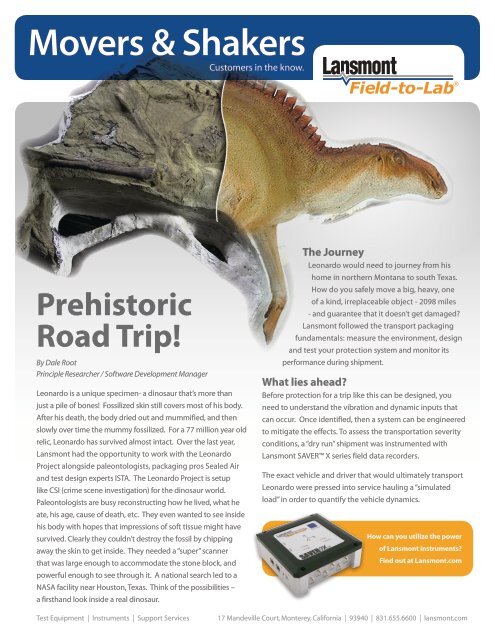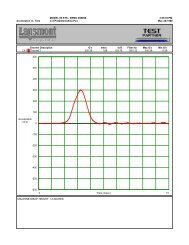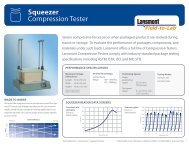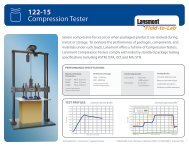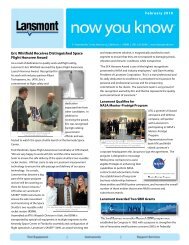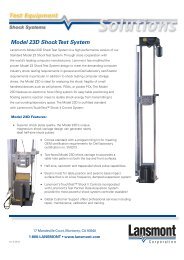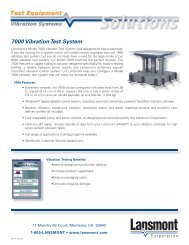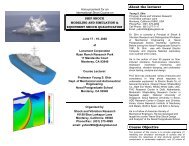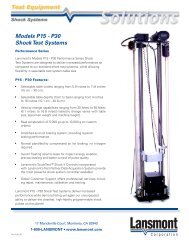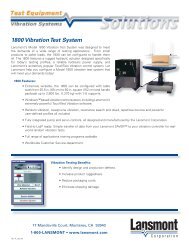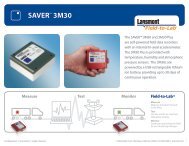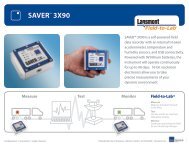Customer Stories - Lansmont Corporation
Customer Stories - Lansmont Corporation
Customer Stories - Lansmont Corporation
You also want an ePaper? Increase the reach of your titles
YUMPU automatically turns print PDFs into web optimized ePapers that Google loves.
Movers & Shakers<br />
<strong>Customer</strong>s in the know.<br />
Prehistoric<br />
Road Trip!<br />
By Dale Root<br />
Principle Researcher / Software Development Manager<br />
Leonardo is a unique specimen- a dinosaur that’s more than<br />
just a pile of bones! Fossilized skin still covers most of his body.<br />
After his death, the body dried out and mummified, and then<br />
slowly over time the mummy fossilized. For a 77 million year old<br />
relic, Leonardo has survived almost intact. Over the last year,<br />
<strong>Lansmont</strong> had the opportunity to work with the Leonardo<br />
Project alongside paleontologists, packaging pros Sealed Air<br />
and test design experts ISTA. The Leonardo Project is setup<br />
like CSI (crime scene investigation) for the dinosaur world.<br />
Paleontologists are busy reconstructing how he lived, what he<br />
ate, his age, cause of death, etc. They even wanted to see inside<br />
his body with hopes that impressions of soft tissue might have<br />
survived. Clearly they couldn’t destroy the fossil by chipping<br />
away the skin to get inside. They needed a “super” scanner<br />
that was large enough to accommodate the stone block, and<br />
powerful enough to see through it. A national search led to a<br />
NASA facility near Houston, Texas. Think of the possibilities –<br />
a firsthand look inside a real dinosaur.<br />
The Journey<br />
Leonardo would need to journey from his<br />
home in northern Montana to south Texas.<br />
How do you safely move a big, heavy, one<br />
of a kind, irreplaceable object - 2098 miles<br />
- and guarantee that it doesn’t get damaged?<br />
<strong>Lansmont</strong> followed the transport packaging<br />
fundamentals: measure the environment, design<br />
and test your protection system and monitor its<br />
performance during shipment.<br />
What lies ahead?<br />
Before protection for a trip like this can be designed, you<br />
need to understand the vibration and dynamic inputs that<br />
can occur. Once identified, then a system can be engineered<br />
to mitigate the effects. To assess the transportation severity<br />
conditions, a “dry run” shipment was instrumented with<br />
<strong>Lansmont</strong> SAVER X series field data recorders.<br />
The exact vehicle and driver that would ultimately transport<br />
Leonardo were pressed into service hauling a “simulated<br />
load” in order to quantify the vehicle dynamics.<br />
How can you utilize the power<br />
of <strong>Lansmont</strong> instruments?<br />
Find out at <strong>Lansmont</strong>.com<br />
Test Equipment | Instruments | Support Services 17 Mandeville Court, Monterey, California | 93940 | 831.655.6600 | lansmont.com
3x90 mounted and ready to monitor trip to Houston.<br />
Putting knowledge to the test<br />
Data from the “dry run” was pored over, pondered, and<br />
analyzed, ultimately culminating in a test specification and<br />
design goal which Armstrong’s team could use to develop<br />
the protection system. When it came time to make the trip<br />
for real, <strong>Lansmont</strong> monitored both the truck and the crate in<br />
which Leonardo rode. The instruments could feel how the<br />
truck moved, and how Leonardo responded to that input. This<br />
allowed us to verify that vehicle dynamics had not changed<br />
since the “dry run” and to ensure continuity with the original<br />
design goal. It also allowed us to observe the performance of<br />
the protection system in action.<br />
SaverXware has been used to produce 3D tours of the<br />
spatially aware data recorded during the trip for display with<br />
Google Earth. If you would like to explore the trip and data:<br />
Go to www.<strong>Lansmont</strong>.com for instructions on setting up<br />
Google Earth to view actual data from the trip.<br />
The Leonardo Project has been chronicled in a new Discovery<br />
Channel documentary titled Secrets of the Dinosaur Mummy<br />
which aired September 14th, 2008.<br />
<strong>Lansmont</strong> <strong>Corporation</strong> is the world’s leading provider of state-<br />
of-the-art measurement, testing and monitoring equipment,<br />
software, education, and analytical services. Product and pack-<br />
aging engineers around the world rely on <strong>Lansmont</strong> equipment<br />
to discover the limits and eliminate the unknowns in transport<br />
and in-use environments. Successful companies trust <strong>Lansmont</strong><br />
tools and experience to help them design stronger, more durable<br />
products capable of surviving the rigors of real world use, and<br />
delivering them safely in minimal, but effective packaging.<br />
Significant Vibration Events<br />
<strong>Lansmont</strong> SaverXware used the spatially aware data, recorded by the<br />
<strong>Lansmont</strong> instruments, to generate a 3D Google Earth view of the trip.<br />
” The instruments<br />
could feel how the<br />
truck moved, and<br />
how Leonardo<br />
responded to that<br />
input . . . and allowed<br />
us to observe the<br />
performance of the<br />
protection system<br />
in action. ”<br />
Test Equipment | Instruments | Support Services 17 Mandeville Court, Monterey, California | 93940 | 831.655.6600 | lansmont.com


